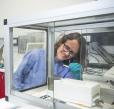Australia’s nuclear science capabilities have been central to our fight against COVID-19
ANSTO scientists share approach on the global stage at the IAEA General Conference.

Showing 1861 - 1880 of 3509 results
ANSTO scientists share approach on the global stage at the IAEA General Conference.
Australia’s new Mo-99 manufacturing facility reaches practical completion
Training hosted and delivered by ANSTO on behalf of the IAEA assisted the Philippine Nuclear Research Institute (PNRI) to prepare for the successful management of a recent nuclear forensics operation.
Insights into the crystallisation process of twin crystals important for drug production.

Elastic Recoil Detection Analysis (ERDA) is used principally as a method for measuring hydrogen in thin layers, and in the near-surface region of materials.
In a world-first study, Australian environmental scientists have used cave stalagmites as a record of groundwater replenishment over time, that showed the current level of rainfall recharging groundwater in southwest WA is at its lowest for at least the last 800 years.
An Australian-led international research team, including a core group of ANSTO scientists, has found that doping a promising material provides a simple, effective method capable of extracting uranium from seawater.
ANSTO has hosted for the third time the International Atomic Energy Agency’s (IAEA) Practical Introduction to Nuclear Forensics Regional Training Course.
Understanding of micro-structure gained using X-ray scattering and spectroscopy.
ANSTO has been granted a patent in Australia and a number of European countries for the separation, a key radioactive contaminant in critical minerals processing, actinium-227, from process liquors used in minerals extraction.

All safety requirements must be met while working at the Australian Centre for Neutron Scattering. Failure to do so may result in the suspension of experiments.

New energy technologies, including hydrogen production, are being investigated to achieve decarbonisation.
Dr Andrew Smith has just finished collecting ice cores and snow samples on the summit of Law Dome in Antarctica,

The Australian Nuclear Medicine Traceability Program (ANMTP) assists practices administering nuclear medicine-based radionuclides to achieve regulatory compliance by providing measurement traceability to the Australian Standard.